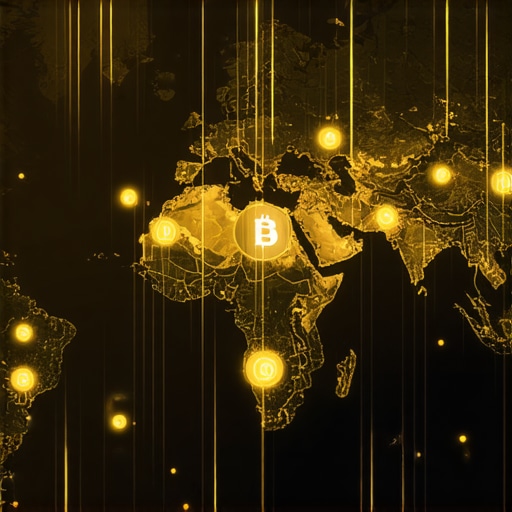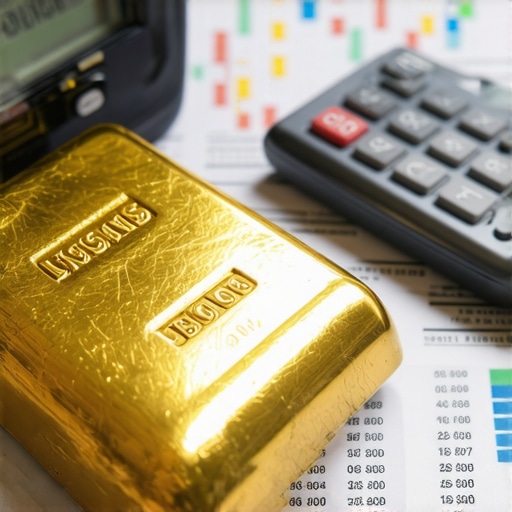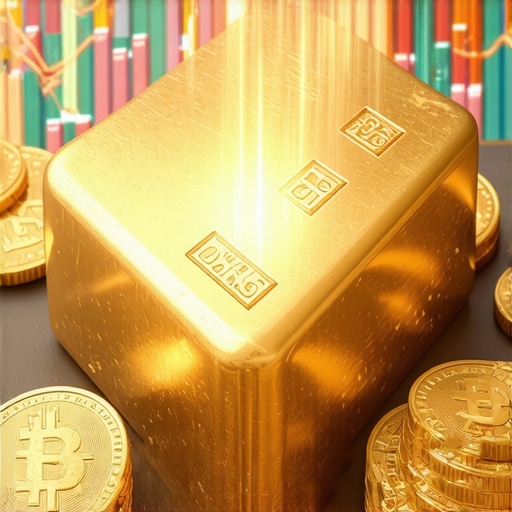The Strategic Significance of Analyzing Gold Demand Drivers in a Turbulent Global Economy
In the realm of precious metals, gold remains a cornerstone asset, revered not only for its intrinsic value but also for its role as a barometer of economic stability and geopolitical confidence. As we approach 2025, understanding the multifaceted demand drivers becomes crucial for investors and policymakers alike, especially given the evolving macroeconomic landscape and technological innovations impacting gold consumption patterns.
Deciphering the Influences Behind Gold Demand Cycles: An Expert Perspective
Gold demand is shaped by a confluence of factors—ranging from jewelry consumption and central bank policies to investment behaviors and technological applications. According to recent analyses by the World Gold Council, shifts in investor sentiment driven by inflation expectations and currency fluctuations significantly influence demand dynamics. For instance, demand-supply trends in 2025 suggest a nuanced interplay where geopolitical tensions and monetary easing policies could catalyze increased gold purchasing, especially through ETFs and physical assets.
How Will Emerging Economic Trends Shape Gold Price Trajectories in 2025?
Emerging economic trends, such as the digital economy’s expansion and the shift towards sustainable investments, are poised to redefine gold’s role within diversified portfolios. The ongoing transition towards green finance may elevate gold’s status as a hedge against climate-related financial risks, as discussed in recent white papers from financial research institutions. Moreover, fluctuations in global economic growth—particularly in emerging markets—will influence gold’s demand as a store of value and a safe haven asset. For an in-depth analysis, see gold price trend predictions.
What are the potential grey areas or debates among experts regarding future gold demand and prices?
Among experts, a key debate centers on whether central bank gold purchases will sustain their current momentum or taper off as monetary policies normalize. Some analysts argue that rising geopolitical tensions could induce further accumulation, while others caution against overreliance on central bank activities as a price driver, citing potential shifts in global reserves strategies. Additionally, the impact of technological innovations—such as blockchain-based assets—raises questions about the future of physical gold demand. Engage with our comprehensive resources or contribute your insights to enrich this ongoing dialogue.
For a strategic overview on how to capitalize on these demand drivers, explore gold investment strategies tailored for 2025, and stay ahead of market shifts. As the landscape evolves, continuous analysis from authoritative sources remains essential for making informed decisions in the golden realm of wealth preservation and growth.
Advanced Insights into Gold Demand Dynamics: What Experts Are Predicting for 2025
As we delve deeper into the evolving landscape of gold demand, it becomes apparent that multifaceted factors are increasingly influencing market trajectories. From technological innovations to geopolitical developments, each element plays a nuanced role in shaping investor behavior and industry trends. According to a comprehensive report from the World Gold Council, understanding these complex interactions is essential for crafting resilient investment strategies and anticipating future price movements.
Can Technological Progress Disrupt Traditional Gold Demand Patterns?
One of the most compelling debates among industry experts revolves around the potential for blockchain and digital asset innovations to transform gold’s role in the financial ecosystem. While physical gold remains a timeless store of value, emerging digital representations—such as tokenized gold—offer liquidity and accessibility that could redefine demand, especially among younger investors. As highlighted by credible sources like understanding gold demand cycles, these innovations may either complement or compete with traditional gold investments, creating new opportunities and risks.
How Can Investors Balance Traditional and Innovative Gold Assets for Long-Term Growth?
Developing a balanced portfolio that incorporates both physical gold and digital assets requires an understanding of market liquidity, security, and regulatory landscapes. Expert advice suggests diversifying across gold coins, bars, ETFs, and emerging blockchain-based tokens to mitigate risks and capitalize on potential growth drivers. For more tailored insights, explore gold investment strategies designed specifically for the 2025 market environment. As the industry continues to innovate, staying informed through authoritative analyses becomes vital.
Furthermore, geopolitical shifts and central bank policies are expected to remain pivotal in influencing demand. For instance, increased central bank purchases, as discussed in central bank gold purchases, could drive prices higher if these trends persist against a backdrop of global economic uncertainty. Conversely, technological disruptions might introduce volatility, necessitating vigilant risk management and strategic planning.
Engagement from seasoned investors and newcomers alike can be enriched by participating in forums, sharing insights, and reading detailed market analyses. For example, staying updated with market analysis trends can reveal emerging opportunities and warn of potential risks before they materialize. This proactive approach ensures that your gold investments remain aligned with global economic realities and technological advancements.
In conclusion, the future of gold demand in 2025 hinges on a delicate interplay between traditional market drivers and innovative disruptions. By integrating expert insights, embracing technological progress, and maintaining a diversified investment approach, investors can better position themselves to navigate the complexities of this dynamic market landscape.
Harnessing Blockchain and Digital Assets: The Future of Gold Demand in the Digital Age
The advent of blockchain technology has already begun to revolutionize how investors perceive and utilize gold assets. Tokenized gold—digital representations backed by physical gold—offers unprecedented liquidity and ease of transfer, making gold more accessible to a broader demographic, especially younger, tech-savvy investors. This innovation not only democratizes access but also introduces new layers of transparency and security, leveraging the immutable nature of blockchain to verify authenticity and ownership.
According to a detailed report from the Blockchain Insights Institute, the market for tokenized gold could grow by over 35% annually through 2025, potentially capturing a significant share of traditional gold investment channels. This shift raises critical questions about how physical gold and its digital counterparts will coexist, compete, or complement each other in diversified portfolios.
How Can Investors Effectively Balance Traditional and Digital Gold Assets for Resilient Growth?
Balancing physical gold investments with digital tokens requires a nuanced understanding of security protocols, liquidity profiles, and regulatory frameworks. Experts recommend a diversified approach: holding physical gold for its proven store of value, complemented by digital tokens for liquidity and rapid transaction capabilities. Platforms like SecureGold are pioneering secure and regulated marketplaces for tokenized gold, enabling seamless trading while safeguarding investor interests.
Moreover, regulatory clarity remains paramount. As jurisdictions evolve their legal stance on digital assets, staying informed through authoritative sources such as the Financial Regulatory Authority ensures compliance and minimizes risks. This strategic integration allows investors to capitalize on technological innovations without compromising security or legal standing.
Geopolitical Tensions: A Catalyst for Gold’s Safe Haven Status?
Global geopolitical tensions—be it conflicts, trade disputes, or diplomatic standoffs—continue to serve as potent catalysts for gold demand. Historically, periods of heightened uncertainty lead to increased central bank purchases and elevated investor allocations toward gold as a hedge against currency depreciation and financial instability. Recent data from the International Reserves Council indicate a steady uptick in official gold reserves held by nations amidst geopolitical upheavals.
In the context of 2025, escalating tensions in regions like the South China Sea or Eastern Europe could trigger a surge in gold buying, especially if accompanied by fiat currency volatility. Central banks, as major players, may continue or even accelerate their gold accumulation strategies, reinforcing gold’s status as a reliable reserve asset. This dynamic underscores the importance for investors to monitor geopolitical developments and central bank policies closely, integrating these insights into their risk management frameworks.
< >
>
Image prompt: A high-resolution image depicting a digital map overlay with gold bars and blockchain symbols, illustrating the fusion of traditional gold and digital assets in a global context.
For those seeking to deepen their strategic understanding, exploring expert analyses on the intersection of geopolitics, technology, and gold markets is essential. Consider subscribing to specialized financial risk assessment reports or engaging with industry webinars focusing on 2025 market forecasts.
Expert Forecasts and Strategic Recommendations for 2025
Leading analysts project that the interplay of technological advancements and geopolitical developments will define gold’s trajectory in 2025. While digital gold assets may attract a new generation of investors, traditional physical gold is expected to retain its core role as a safe haven, especially during periods of acute instability. Portfolio diversification strategies should incorporate both forms, emphasizing security, liquidity, and compliance.
Furthermore, staying agile and informed is crucial. Regularly consulting authoritative sources such as the World Gold Council and regional financial regulators can provide timely insights that enable proactive decision-making. As the landscape continues to evolve, fostering a comprehensive understanding of emerging risks and opportunities will distinguish successful investors from the rest.
To explore tailored investment strategies that align with your risk appetite and market outlook, consider engaging with expert financial advisors specializing in precious metals and digital assets. The confluence of innovation, geopolitics, and economic policy in 2025 promises both challenges and unparalleled opportunities for astute investors willing to adapt and innovate.
Unlocking the Next Phase of Gold Demand: Emerging Trends and Expert Perspectives
As the landscape of global finance and geopolitics continues to evolve, gold remains an indispensable asset class with multifaceted demand drivers. Recent studies emphasize the growing importance of technological innovation, geopolitical stability, and sustainable investing trends in shaping gold’s trajectory toward 2025. Experts suggest that understanding these nuances is critical for investors seeking to optimize portfolio resilience and growth in an increasingly complex environment.
The Synergy of Digital Transformation and Gold’s Traditional Appeal
The advent of blockchain and digital asset ecosystems has begun to redefine gold’s role as a safe haven and liquidity vehicle. Tokenized gold, backed by physical reserves and transacted on secure blockchain platforms, offers unparalleled transparency and accessibility, appealing particularly to younger, tech-savvy investors. According to a comprehensive report by the Blockchain Insights Institute, the tokenized gold market is projected to grow exponentially, potentially capturing a significant share of conventional gold investment channels by 2025. This technological shift not only democratizes access but also introduces new dynamics in demand and price discovery.
How Will Regulatory Landscapes Influence Digital and Physical Gold Markets?
Regulatory frameworks are pivotal in shaping the future of gold investment. As jurisdictions worldwide grapple with integrating digital assets into existing financial systems, clarity and compliance standards are evolving. Investors must stay informed about legal developments from authoritative sources like the Financial Regulatory Authority, which will influence market accessibility, security protocols, and cross-border transactions. Navigating these regulatory nuances is essential for safeguarding investments and maximizing returns in both traditional and digital gold markets.
What Role Do Geopolitical Risks Play in Sustaining Gold’s Safe Haven Status?
Geopolitical tensions—ranging from regional conflicts to trade disputes—continue to underpin gold’s reputation as a crisis hedge. Data from the International Reserves Council indicates a steady increase in official gold reserves amidst global unrest, reinforcing gold’s intrinsic value during periods of uncertainty. Future conflicts or diplomatic standoffs in strategic regions such as the South China Sea or Eastern Europe could trigger surges in physical and digital gold demand, especially if currency and financial markets experience heightened volatility. Investors are advised to monitor geopolitical developments closely and integrate these insights into risk management strategies.
Can Technological Disruptions Catalyze a Paradigm Shift in Gold’s Market Dynamics?
Technological innovations—particularly blockchain-based tokens and digital safes—pose both opportunities and challenges for traditional gold markets. While physical gold retains its status as a tangible store of value, digital representations could foster increased liquidity, ease of transfer, and expanded investor participation. However, concerns regarding security, regulatory compliance, and market perception persist. Experts recommend a balanced approach: combining physical holdings with digital assets to diversify risk and leverage growth potentials. Platforms like SecureGold exemplify how secure and regulated digital gold trading can complement existing investment strategies.
How Can Investors Strategically Balance Traditional and Digital Gold Assets for Long-Term Success?
Developing a resilient investment portfolio involves integrating physical gold with innovative digital assets. Diversification across gold coins, bars, ETFs, and tokenized gold ensures liquidity, security, and adaptability to regulatory changes. Staying informed through authoritative sources such as the World Gold Council and financial regulators enhances decision-making and risk mitigation. Engaging with seasoned advisors specializing in precious metals and blockchain assets can further refine strategies, ensuring alignment with evolving market conditions.
It is also vital to remain vigilant about geopolitical developments and central bank policies. As reported by the Central Bank News, increased official gold purchases by nations signal a sustained commitment to gold reserves, which could influence prices and demand patterns. Strategic diversification, coupled with ongoing education and market analysis, will empower investors to navigate the uncertainties and seize emerging opportunities in the gold market landscape.
Conclusion: Embracing Innovation and Vigilance in Gold Investment Strategies
Looking ahead to 2025, the confluence of technological advancements, geopolitical risks, and regulatory evolutions will define gold’s demand dynamics. Investors who proactively adapt by embracing digital innovations, monitoring geopolitical shifts, and adhering to compliance standards will position themselves advantageously. Engaging with expert analyses and leveraging diversified asset classes will be critical in building resilient, future-proof portfolios in the ever-changing landscape of gold investment.
Expert Insights & Advanced Considerations
1. Technological Innovation as a Demand Catalyst
Emerging technologies like blockchain tokenization are transforming gold investment landscapes, offering increased liquidity and accessibility that attract younger investors and diversify demand sources beyond traditional channels.
2. Geopolitical Risks Reinforcing Gold’s Safe Haven Status
Ongoing geopolitical tensions, such as conflicts in strategic regions, continue to bolster gold reserves held by nations and elevate demand among investors seeking stability amid global unrest.
3. Regulatory Frameworks Shaping Market Access
Legal clarity and evolving regulations around digital assets are critical for market participation, impacting the growth of digital gold assets and influencing investor confidence in compliance and security standards.
4. Central Bank Policies and Gold Accumulation
Central banks’ continued or increased gold purchases serve as a strong indicator of gold’s enduring role as a reserve asset, affecting market dynamics and price trajectories in 2025.
5. Sustainability Trends Elevating Gold’s Portfolio Role
Growing emphasis on sustainable investing may position gold as a hedge against climate-related financial risks, further integrating it into diversified, responsible investment strategies for long-term resilience.
Curated Expert Resources
- World Gold Council: Renowned for comprehensive market analysis, demand-supply insights, and strategic reports on gold trends, essential for industry professionals.
- Blockchain Insights Institute: Provides in-depth research on the digital transformation of gold markets, including tokenization and blockchain applications, valuable for understanding technological impacts.
- Financial Regulatory Authority: Offers authoritative updates on evolving regulations affecting digital and physical gold markets, crucial for compliance and strategic planning.
- International Reserves Council: Tracks official gold reserves and geopolitical trends, informing risk assessment and demand forecasts.
- Regional Central Banks’ Publications: Key sources for policy shifts and central bank strategies influencing gold accumulation and market stability.
Final Expert Perspective
Understanding the nuanced interplay of technological innovation, geopolitical stability, and regulatory evolution is essential for mastering gold demand dynamics in 2025. By leveraging insights from authoritative sources and adapting investment strategies accordingly, investors can position themselves advantageously in this complex landscape. Engage with industry webinars, contribute your expertise, and explore advanced resources to stay ahead in the ever-evolving world of gold investment—your strategic edge in a future shaped by innovation and resilience.










